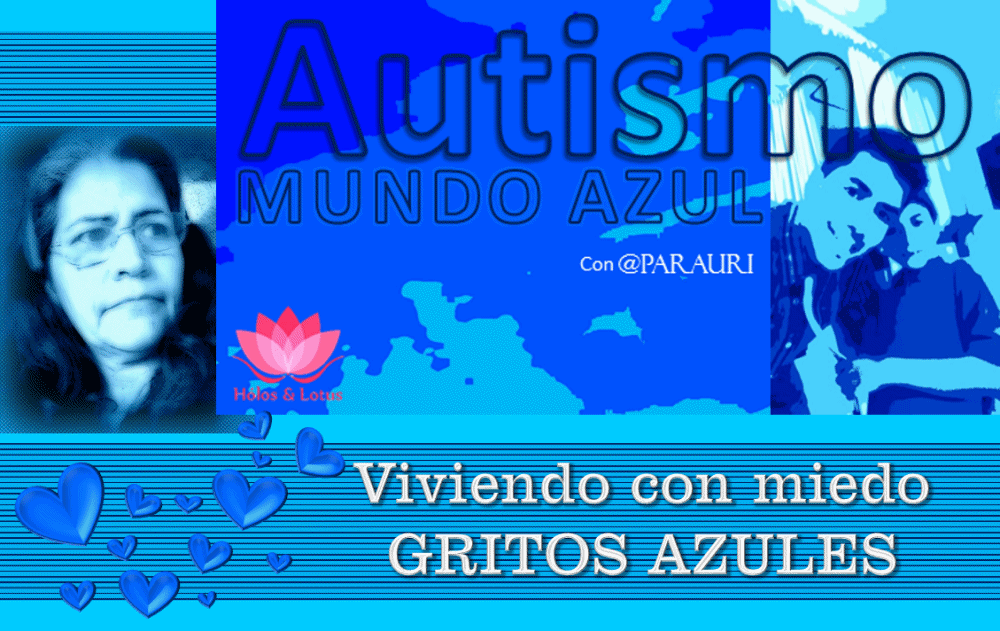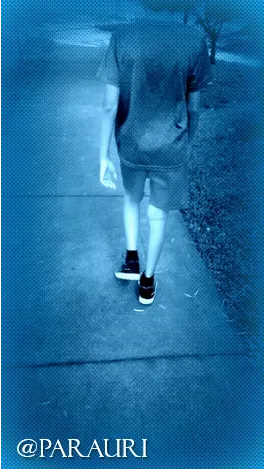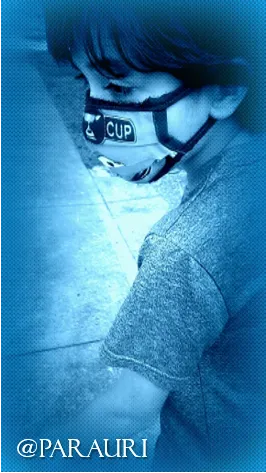
Hola, reciban mi saludo especial y azul. Bienvenidos a una nueva edición de Autismo: Mundo Azul desde mi otro rinconcito especial en Hive y es la comunidad para el crecimiento del ser en bienestar integral, @holos-lotus. Bien, estuve meditando en una de las realidades de las personas con Trastorno del Espectro Autista y es estar bajo la sombra del miedo. Por supuesto, que el bienestar depende en gran medida de la atención especializada y familiar que se reciba desde el inicio del diagnóstico de autismo, sin embargo, las personas autistas tienen capacidad adaptativa lo que les permite un camuflaje de sus puntos débiles, los cuales se relacionan con la interacción social, lo que incluye la comunicación, entre otras cosas, pero en esta edición me centro en el miedo que les produce relacionarse.
Interactuar y comunicarse, la verdad es una prueba de fuego para las personas con autismo, incluso en aquellos que parezcan muy extrovertidos, pues al percibir un reproche o una burla, un gesto que los señalen y hagan sentir rechazados, se desboronan fortaleciéndose su inseguridad. Como ves, me estoy refiriendo al autismo leve y moderado, que son los niveles de autismo que tienen mayor posibilidad de llevar una vida con mayor interacción e independencia.
Miedo a socializar
La inseguridad es lo que hace que las personas con autismo, vivan bajo constante miedo a enfrentar a las personas, a desenvolverse en la sociedad, a tener interacciones sociales, a tener comunicación y todos estos son problemas de la conducta que disminuye la posibilidad de lograr una vida independiente. Recordemos que en el autismo se percibe el mundo de forma distinta y por eso los cuidadores debemos actuar adaptándonos a sus necesidades porque de lo contrario le hacemos la vida a los autistas, más cuesta arriba gracias a sus miedos (1) que se van incrementando y los van aislando más. Mi hijo menor, tienes muchos temores, cuando tiene alguna interacción por pequeña que sea, siente que no puede respirar y le provoca salir corriendo, solo que como está más grande ha concienciado algunas situaciones y se obliga a enfrentar sus miedos para socializar, aunque pasa más tiempo solo.

Gritos azules
Bien vale la pena no desestimar la atención a nivel neurológico y psicológico que se necesita para el abordaje del autismo, porque hay otro punto de mucha importancia y es que las personas con autismo tienen mayores posibilidades de desarrollar depresión (2) más que la población típica de padecer esta enfermedad mental que ha asesinado a muchas personas con autismo. Esto se debe a que muchos tienen antecedentes de depresión con una vida de sufrimiento, de padecimiento de todo tipo de acoso, lo que conlleva a una vida triste y con más miedos… reflejado en los gritos azules del autismo.
Especialmente cuando los niños con autismo van aumentando en edad y sobre todo cuando ya son adultos, se puede evidenciar la presencia de algunos síntomas de depresión. Al crecer también crecen los miedos hacia la interacción social, lo que forma en la cabeza como un remolino que causa mucho malestar para él, para el cuidador y para todos los que están en su entorno. La depresión puede estar solapada y confundida con las características del autismo, lo que dificulta su diagnóstico a tiempo y cuando ya se está frente a una depresión profunda es que se puede entender que desde hace tiempo ha existido una depresión mal atendida. Eso es muy delicado porque la depresión es un monstruo que se presenta como una pequeña tristeza pero que crece rápido convirtiéndose en un gigante con ideas suicidas, así los gritos azules suenan más altos pidiendo auxilio, pero no siempre se oyen a tiempo.

Algunas señales de depresión
En las personas con autismo la depresión no se puede detectar como en las personas neurotípicas, pues como dije antes, en el autismo se ven los síntomas cuando está avanzada la depresión y es esencial su diagnóstico a tiempo, así que, con mucha atención hay que observar los cambios en la conducta autista para detectar algunas señales que alerten una depresión. Por ejemplo, las características propias del autismo se acentúan cuando hay mucha ansiedad, estrés, angustia, que son estados muy frecuentes en las personas con TEA y de allí se está a un paso muy corto de un estado de depresión. Mira algunas señales de depresión:
Estereotipias incrementadas, frecuentes y más severas, como frotarse las manos, caminar en circulo, apretarse un brazo.
Inquietud más de lo normal.
Rabietas con agresividad.
Sentimientos de frustración.
Autoagresión con mayor frecuencia, como golpearse o pellizcarse.
Desanimo para hacer las cosas cotidianas.
Retraído más que de costumbre.
Sentimientos de tristeza prolongados.
Obsesión con la muerte.
Expresiones suicidas o hablar directamente de suicidio, como: "otro día para morir", "¿hasta cuándo vivir?"

Quiero hacer mención nuevamente de mi hijo menor, porque cuando hay enfermedades hay mucha ansiedad y estrés, ya lo he dicho en otras publicaciones, él tiene hipertensión ocular y eso influye en su ansiedad. Además, cuando hay un ambiente tenso, eso hace que sus angustias se incrementen porque los autistas son muy sensibles emocionalmente.
Por otro lado, al parecer la depresión en mujeres con autismo es más frecuente, lo que suponen algunos expertos es que esto esté relacionado a un diagnóstico de autismo más tardío en las hembras y por ende los abordajes son inadecuados. Esta falta de detección temprana del TEA en las niñas, las obliga a lidiar más con las dificultades sociales y es mayor su tendencia a “camuflar sus síntomas para encajar mejor socialmente" mientras pasan los años viviendo incomprendidas.
¿Cómo ayudar?
Por supuesto, que el apoyo familiar es importante pero cuando se trata de depresión es muy necesario recibir atención psicología profesional, donde el especialista, dependiendo del caso, ordenará sesiones terapéuticas psicológicas o remitirá al paciente a otro especialista en el área de psiquiatría, quien puede indicar tratamiento médico oral o inyectado. Sin embargo, también puede haber un acuerdo para que a través de estrategias psicológicas bien dirigidas por un profesional se preste atención al chico o persona con autismo, las cuales pueden ser:
Trabajar la autoestima: Esto se puede hacer a través de actividades que sean de interés y de dominio del chico o la persona autista, es decir que tenga la oportunidad de demostrar su habilidad para realizarlas y es muy importante que se hagan en un área donde se sienta bien, no obligado para que disfrute de las actividades, la idea es que sea feliz.
Usar estrategias de afrontamiento: Para que el chico o persona azul tenga la oportunidad de compartir, de socializar, de controlar la ira, solucionar problemas y manejar el estrés.

Por otro lado, es de mucha ayuda que los chicos tengan acceso a la escolaridad y a las actividades complementarias. Esto les beneficia en el desenvolvimiento social al interactuar con otras personas, les permite desarrollar habilidades de comunicación, crear lazos de amistad de acuerdo a la edad y al nivel de autismo, porque los autistas, incluyendo los severos, tienen capacidad de aprender algunas habilidades adaptativas, lo que les permite independencia y por ende menos aprehensión o apego emocional ansioso, del que podríamos hablar en otra oportunidad, nuevamente, pues hace tiempo hablamos de ello. Sin embargo, creo que es muy necesario continuar hablando, en las siguientes ediciones, sobre los miedos en el autismo.
Será de mucha ayuda que puedas dejar tu comentario en relación al tema de esta edición, sobre el miedo a la interacción social en el autismo. Así todos podemos crecer juntos en conocimientos, porque las dudas de unos puede ser la luz para otros.

IMPORTANTE: El diagnóstico del TEA debe estar a cargo de especialistas.
AUTISMO: Mundo Azul 💙
Puedes visitar mi página: Autismo: Un Mundo Excepcional
Conoce su Proyecto en HIVE: Comunidad MUNDO AUTISMO
Artículos citados con enlaces dentro de mi contenido
y que les recomiendo leer:
1 "El Asperger y el miedo" - Autismo Diario
2. "The deep emotional ties between depression and autism" - SPECTRUM
Banner de la Columna diseñado por @parauri.
Fotos y todas las imágenes propias.


Hello, receive my special blue greeting. Welcome to a new edition of Autism: Blue World from my other special little corner in Hive and that is the community for the growth of the self in integral wellness, @holos-lotus. Well, I was meditating on one of the realities of people with Autism Spectrum Disorder and that is being under the shadow of fear. Of course, wellness depends largely on the specialized and family care received from the beginning of the diagnosis of autism, however, autistic people have adaptive capacity which allows them to camouflage their weaknesses, which are related to social interaction, including communication, among other things, but in this issue I focus on the fear that causes them to relate.
Interacting and communicating, the truth is a trial by fire for people with autism, even in those who seem to be very extroverted, because when they perceive a reproach or a mockery, a gesture that points them out and makes them feel rejected, they become overwhelmed, strengthening their insecurity. As you can see, I am referring to mild and moderate autism, which are the levels of autism that have a greater possibility of leading a life with more interaction and independence.
Fear of socializing
Insecurity is what causes people with autism to live under constant fear of facing people, to develop in society, to have social interactions, to have communication and all these are behavioral problems that decrease the possibility of achieving an independent life. Let us remember that in autism the world is perceived differently and that is why caregivers must act adapting to their needs because otherwise we make life more difficult for autistic people thanks to their fears (1) that increase and isolate them even more. My youngest son, you have many fears, when he has any interaction no matter how small it is, he feels he can't breathe and it makes him run away, but as he is older he has become aware of some situations and forces himself to face his fears to socialize, although he spends more time alone.

Blue screams
It is well worth not underestimating the attention at the neurological and psychological level that is needed in addressing autism, because there is another point of much importance and that is that people with autism are more likely to develop depression (2) more than the typical population to suffer from this mental illness that has killed many people with autism. This is because many have a history of depression with a life of suffering, suffering from all kinds of harassment, leading to a sad life with more fears...reflected in the blue screams of autism.
Especially when children with autism grow older and especially when they are adults, the presence of some symptoms of depression can be evidenced. As they grow older, fears of social interaction also grow, which forms a whirlpool in the head that causes a lot of discomfort for the child, the caregiver and everyone in the environment. Depression can be overlapped and confused with the characteristics of autism, which makes it difficult to diagnose it in time, and when one is already facing a deep depression, one can understand that there has been a poorly treated depression for a long time. That is very delicate because depression is a monster that presents itself as a small sadness but that grows quickly becoming a giant with suicidal ideas, so the blue screams sound louder asking for help, but are not always heard in time.

Some signs of depression
In people with autism depression cannot be detected as in neurotypical people, because as I said before, in autism the symptoms are seen when the depression is advanced and its diagnosis in time is essential, so, with great attention we must observe the changes in the autistic behavior to detect some signs that alert a depression. For example, the characteristics of autism are accentuated when there is a lot of anxiety, stress, anguish, which is a very common condition in people with ASD, and from there it is just a step away from depression. See some signs of depression:
Increased, frequent and more severe stereotypies, such as rubbing hands, walking in a circle, squeezing an arm.
Restlessness more than usual.
Tantrums with aggressiveness.
Feelings of frustration.
More frequent self-injury, such as hitting or pinching.
Discouragement to do everyday things.
Withdrawn more than usual.
Prolonged feelings of sadness.
Obsession with death.
Suicidal expressions or direct talk of suicide, such as, "another day to die," "how long to live?"

I want to mention again my youngest son, because when there are illnesses there is a lot of anxiety and stress, I have already said it in other publications, he has ocular hypertension and that influences his anxiety. Also, when there is a tense environment, that makes his anxieties increase because autistic people are very emotionally sensitive.
On the other hand, it seems that depression in women with autism is more frequent, what some experts suppose is that this is related to a later diagnosis of autism in females and therefore the approaches are inadequate. This lack of early detection of ASD in girls forces them to deal more with social difficulties and their tendency to "camouflage their symptoms to fit in better socially" while they spend years living misunderstood is greater.
How to help?
Of course, family support is important but when it comes to depression it is very necessary to receive professional psychological care, where the specialist, depending on the case, will order psychological therapy sessions or refer the patient to another specialist in the area of psychiatry, who may indicate oral or injected medical treatment. However, there can also be an agreement so that through psychological strategies well directed by a professional, attention is given to the child or person with autism, which can be:
Working on self-esteem: This can be done through activities that are of interest and domain of the child or autistic person, that is to say that they have the opportunity to demonstrate their ability to perform them and it is very important that they are done in an area where they feel good, not forced so that they enjoy the activities, the idea is that they are happy.
Use coping strategies: So that the boy or blue person has the opportunity to share, socialize, control anger, solve problems and manage stress.

On the other hand, it is very helpful for children to have access to schooling and complementary activities. This benefits them in their social development when interacting with other people, allows them to develop communication skills, create friendship bonds according to their age and level of autism, because autistic children, including the severe ones, have the capacity to learn some adaptive skills, which allows them independence and therefore less apprehension or anxious emotional attachment, which we could talk about in another opportunity, again, since we talked about it some time ago. However, I think it is very necessary to continue talking, in the following issues, about fears in autism.
It will be very helpful if you can leave your comment in relation to the topic of this issue, about the fear of social interaction in autism. This way we can all grow together in knowledge, because the doubts of some can be the light for others.

IMPORTANT: The diagnosis of ASD should be made by specialists.
AUTISM: Blue World 💙
You can visit my page: Autismo: Un Mundo Excepcional
Learn about his new Project in HIVE: MUNDO AUTISMO Community
Articles cited with links within my content
and that I recommend you to read:
1. "El Asperger y el miedo" - Autismo Diario
2. "The deep emotional links between depression and autism" - SPECTRUM
Column banner designed by @parauri.
Photos and all own images.

C/Holos&Lotus

Join Telegram Holos&Lotus


Para participar en la iniciativa Palabras que inspiran.
He publishes from the Dapp Ecency
To participate in the Words That Inspire initiative.

Síguenos en Twitter / Follow us on Twitter
Entra a nuestro servidor de Discord en este enlace / Log in to our Discord server at this link 👇


C/Womentribe

Conoce el Mundo Azul en HIVE
C/ MUNDO AUTISMO

Twitter


